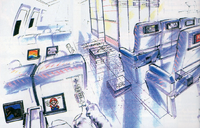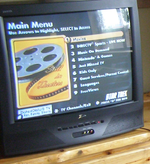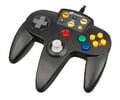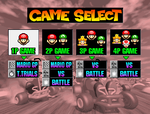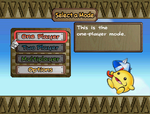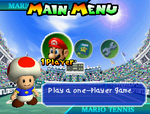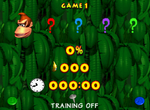LodgeNet
| LodgeNet | |
|---|---|
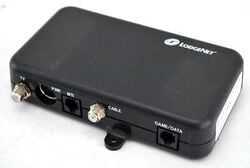 LodgeNet TV Box | |
| Release dates | |
| Discontinued | |
| Predecessor | Super Famicom Box |
LodgeNet, initially known as the Nintendo Gateway System when it was also installed on airplanes in July 1993, was a game streaming service for the SNES, Game Boy, Game Boy Color, Game Boy Advance, Nintendo 64, and Nintendo GameCube, including a variety of games in the Super Mario franchise.[3] While originally designed for planes, the service found more success upon its installation in cruise ships, restaurants, and hotels, starting in December 1993 and continuing until the Chapter 11 bankruptcy of its collaborator LodgeNet Entertainement Corp. on December 31, 2012.[4] Almost all content from the service is now lost, besides 31 games from the Nintendo 64.[5]
Some SNES and Nintendo 64 games were officially modified to reflect that LodgeNet did not support multiplayer,[6] with their original versions' multiplayer functions made inaccessible through various means, including removing menu options entirely or making the multiplayer menu options unable to be selected. Nintendo 64 games could be paused in a frozen state by pushing the ![]() D-pad,[7] Paper Mario received an extra splash screen telling players that pressing the Nintendo 64 LodgeNet controller's Reset button would delete all save data,[8] and Donkey Kong 64 added a "Training" toggle that could be set to off to skip the game's tutorial.[9]
D-pad,[7] Paper Mario received an extra splash screen telling players that pressing the Nintendo 64 LodgeNet controller's Reset button would delete all save data,[8] and Donkey Kong 64 added a "Training" toggle that could be set to off to skip the game's tutorial.[9]
The Nintendo 64 LodgeNet controller did not have a Pak slot and therefore did not support the Controller Pak, Rumble Pak, or Transfer Pak. The slot where all three would have been inserted was replaced with a plastic melded cover with controller support disclaimers on it.
History[edit]
The idea of movies and video games on planes goes back to 1921 and 1975, respectively, with the promotional movie Howdy Chicago!, shown to 11 attendees of Chicago's Pageant of Progress trade show on board an Aeromarine Airways Model 75 amphibian, and a version of Pong that passengers could play on the seatback screens of Braniff International Airways.[10] Nintendo had previously made the Famicom Box and Super Famicom Box, variants of their respective systems for use in hotels and businesses in order to offer games without needing to swap out cartridges.
As the primary audience of video games was children, Nintendo of America saw potential to grow an adult market with in-flight entertainment.[11] In 1992, Nintendo partnered with Hughes-Avicom International and took 18 months developing an on-demand Super Nintendo game service. It was designed to fit a restrictive 3.5-inch × 3.5-inch 0.5 inches, with the logic any services that would fit into a plane could be made to work in other locations, such as hotels. For rows with three seats, three Super Nintendos were combined on the same card (called the Triple Gateway System), while in rows of four seats, two devices would be used. All games were stored on a shared hard drive, and they were downloaded to the two megabytes of memory on the device when played. To make it more appealing to potential customers, and aware of how expensive the service would be, Nintendo added features such as movies, CD recordings, and a phone.[5]
Hotels[edit]
Nintendo partnered with LodgeNet Entertainment Corp. to bring the service to hotels, where it was renamed LodgeNet. Instead of a complete system in each room, a receiver was installed where the controller plugs in. The system then connects to a set of servers in the hotel with a predetermined number of gateway cards.[5] The controller was also redesigned, more closely resembling that of the Super Nintendo but with menu, reset, and volume buttons. Two versions of the controller exist. Both are black with the same-colored buttons, but one has a smaller D-pad, with larger start, select, menu, reset, and volume buttons, while the other is the opposite.
Release[edit]
In July 1993, the Nintendo Gateway System was ready for installations. While the cost of retrofitting planes was high (around $4,000 per seat, approximately $1.5 million for a Boeing 747), airlines such as Air Canada, Alitalia, ANA, BMI, China Airlines, Kuwait Airways, Malaysia Airlines, Northwest Airlines, Singapore Airlines, Thai Airways, and Virgin Atlantic were able to charge $4 an hour for games and $6 for a movie. Nintendo earned $10 million per year off royalties.[5]
LodgeNet was even more successful upon its release in December 1993, with worldwide delivery of SNES games to hotel guests via proprietary building-wide networks.[12] The system was installed in 200,000 hotel guest rooms by April 1996 and 530,000 guest rooms by mid-1999, as reported by LodgeNet.[13] By April 1996, LodgeNet reported that its partnership with Nintendo to deliver SNES games had yielded 200,000 worldwide hotel guest room installations.[13] On June 16, 1998, Nintendo and LodgeNet entered a 10-year licensing agreement for an "aggressive" upgrade to add Nintendo 64 support to their existing 500,000 SNES-equipped guest room installations.[14] According to LodgeNet, within the system's past five years to date, the system had "caused Nintendo to become the most successful new product rollout in the history of the hotel pay-per-view industry."[15] LodgeNet reported that 35 million hotel guests encountered the Nintendo name as an integral amenity within the middle of 1998 alone,[15] and it reported sales of more than 54 million minutes of Nintendo-based gameplay.[16]
LodgeNet and Nintendo began expanding and upgrading their existing SNES systems with Nintendo 64 support on June 10, 1999. LodgeNet reported in mid-1999 that its 530,000 hotel room installations were increasing at a rate of 11,000 rooms per month.[13][16] They began delivering new Nintendo 64 games to hotel rooms at more than 1,000 hotel sites in September 2000, concurrently with the games' retail releases, demonstrating "the capacity to update [LodgeNet's] interactive digital systems with fresh content virtually overnight."[17] The GameCube LodgeNet server used regular Nintendo GameCube memory cards.[18] Game Boy, Game Boy Color, and Game Boy Advance systems were also installed until the early 2000s.
Discontinuation[edit]
While its hotel counterpart was popular into the 2000s, the Nintendo Gateway System was made obsolete by newer in-flight entertainment and not updating past the Super Nintendo, Game Boy, and Game Boy Color, as airlines did not want to reinvest millions of dollars.[5] Game Boy Color games were playable on Singapore Airlines as late as 2012.[19] Soon, the number of hotel rooms with LodgeNet also decreased, going from two million in 2009 to 1.5 million in 2011, due to more competition and the rise of streaming services.[20] LodgeNet Interactive Corp. filed for a prepackaged Chapter 11 bankruptcy on December 31, 2012, and discontinued the service.[4] While it is still possible to find hotels with LodgeNet-equipped rooms, they are becoming increasingly rare.[5]
While no ROMs from the Nintendo Gateway System, or the Super Nintendo, Game Boy, Game Boy Color, Game Boy Advance, and GameCube games from the LodgeNet, have surfaced, preservationists have found a complete system with Nintendo 64 games, recovering 31 of its 38 games, including all eight in the Super Mario franchise and Super Smash Bros.[21] There is also a promotional video from November 2001 with footage of Super Mario World.[22]
List of Super Mario games[edit]
This section does not cite any sources. Unsourced material may be challenged and removed. Specifics: Sources for all games in the list
Please help improve this section by adding citations from reliable sources.
Super Nintendo Entertainment System[edit]
- Donkey Kong Country
- Donkey Kong Country 2: Diddy's Kong Quest
- Dr. Mario
- Super Mario All-Stars
- Super Mario All-Stars + Super Mario World
- Super Mario World
- Wario's Woods
- Tetris & Dr. Mario
- Tetris Attack
Game Boy[edit]
- Baseball
- Dr. Mario
- Game & Watch Gallery
- Golf
- Picross 2
- Super Mario Land
- Super Mario Land 2: 6 Golden Coins
- Wario Land: Super Mario Land 3
- Wario Land II
Game Boy Color[edit]
- Game & Watch Gallery 2
- Game & Watch Gallery 3
- Mario Golf
- Mario Tennis
- Super Mario Bros. Deluxe
- Wario Land 3
Game Boy Advance[edit]
- Dr. Mario & Puzzle League
- Game & Watch Gallery 4
- Mario Kart: Super Circuit
- Mario Pinball Land
- Super Mario Advance 4: Super Mario Bros. 3
- Super Mario World: Super Mario Advance 2
- Wario Land 4
Nintendo 64[edit]
- Donkey Kong 64
- Dr. Mario 64
- Mario Golf
- Mario Kart 64
- Mario Party 3
- Mario Tennis
- Paper Mario
- Super Mario 64
- Super Smash Bros.
Nintendo GameCube[edit]
- Luigi's Mansion
- Mario Golf: Toadstool Tour
- Mario Kart: Double Dash!!
- Mario Party 4
- Mario Party 5
- Mario Party 6
- Mario Party 7
- Mario Power Tennis
- Paper Mario 2
- Super Mario Strikers
- Super Mario Sunshine
- Wario World
- WarioWare, Inc.: Mega Party Game$!
Gallery[edit]
Controllers[edit]
Screenshots[edit]
Game changes[edit]
References[edit]
- ^ a b Evan G.. What is the Nintendo Gateway System?. SNES Central.
- ^ Nintendrew (August 15, 2018). LodgeNet Game Controllers - Nintendo's Hotel Rental Service! | Nintendrew (01:38). YouTube. Retrieved May 29, 2022.
- ^ Famicombro (February 1, 2021). Nintendo Gateway System. Teletype. Retrieved August 28, 2025.
- ^ a b Warner, Melodie (2012-12-31). LodgeNet Files for Chapter 11; Colony Capital Invests $60 Million for Control. The Wall Street Journal. Archived January 2, 2013, 07:39:19 UTC from the original via Wayback Machine. Retrieved 2 January 2013.
- ^ a b c d e f Nintendo Gateway System. Retrieved August 30, 2025 from The Video Game Kraken.
- ^ LodgeNet (partially lost video games from streaming service; mid-1990s to mid-2000s). Lost Media Wiki. Retrieved July 9, 2024.
- ^ "...I just figured out that it doesn't crash but uniquely pauses the game instead, exclusive to the LodgeNet versions. Pushing the directional pads again unpauses it." – July 1, 2023. Kirby 64: The Crystal Shards (LodgeNet 64 version). YouTube @birby100. Retrieved July 9, 2024.
- ^ "If Reset button on Controller is pressed during game, all previously saved data will be lost. Press
 to continue." – June 19, 2023. Paper Mario (LodgeNet 64 version). YouTube @birby100. Retrieved July 9, 2024.
to continue." – June 19, 2023. Paper Mario (LodgeNet 64 version). YouTube @birby100. Retrieved July 9, 2024.
- ^ "The version of the game compiled for this system has a "Training" toggle when starting a new file. If training is turned off, the Cranky barrels will not appear at the start of the game and Donkey Kong will have instant access to his basic moves." – Donkey Kong 64. The Cutting Room Floor. Retrieved July 9, 2024.
- ^ August 18, 2023. The Future of Gaming Devices and Advanced Gaming Technology in Commercial Airline IFE. Retrieved August 30, 2025 from Rosen Aviation.
- ^ January 25, 2024. Nintendo’s Clever Move: Bringing Mario to the Grown-Ups. Retrieved August 30, 2025 from The NES Page.
- ^ Nintendo of America, Inc. (December 3, 1996). https://www.google.com/patents/US5581270 Hotel-based video game and communication system. Google Patents. Retrieved August 7, 2023.
- ^ a b c LodgeNet Entertainment Corporation - Company Profile, Information, Business Description, History, Background Information on LodgeNet Entertainment Corporation. Reference for Business (English). Retrieved August 7, 2023.
- ^ LodgeNet Entertainment Corporation (June 16, 1998). LodgeNet, Nintendo Sign N64 Agreement. PR Newswire. Archived March 4, 2016, 02:38:49 UTC from the original via Wayback Machine. Retrieved May 30, 2024.
- ^ a b LodgeNet Entertainment Corporation (September 3, 1998). LodgeNet, Nintendo Celebrate Guest Room Video Game Milestone. PR Newswire. Archived March 4, 2016, 06:04:53 UTC from the original via Wayback Machine. Retrieved May 30, 2024.
- ^ a b LodgeNet Entertainment Corporation (June 10, 1999). LodgeNet Begins Installing Hotels With Nintendo 64 Game Systems; Initiative Includes New Installations, System Upgrades for Thousands of Hotel Rooms. PR Newswire. Archived March 4, 2016, 02:39:08 UTC from the original via Wayback Machine. Retrieved May 30, 2024.
- ^ LodgeNet Entertainment Corporation (August 29, 2000). LodgeNet Brings Mario Tennis(TM) to Hotel Guests Nationwide; New N64(R) Game Will Appear in Stores, Hotel Rooms Same Week. PR Newswire. Retrieved May 30, 2024.
- ^ billyseven. Nintendo Lodgenet GameCube Gateway black memory card.. Flickr. Retrieved May 30, 2024.
- ^ June 1, 2012. Singapore Airlines Gateway Game Boy. Tatanga290. Retrieved September 6, 2025 from YouTube.
- ^ Jane L. Levere (June 1, 2013). The TV Loses Its Top Spot in Hotel-Room Entertainment. The New York Times.
- ^ togemet2 (April 25, 2023). Nintendo LodgeNet 64 (Gateway System) ROM Collection. Forest of Illusion. Archived April 26, 2023, 00:02:19 UTC from the original via Wayback Machine. Retrieved September 6, 2025.
- ^ April 12, 2023. Lodgenet promos (November 2001). Rollbots Fan. Retrieved September 6, 2025 from YouTube.
| Game Boy games | |
|---|---|
| Super Mario franchise | Alleyway (1989) • Baseball (1989) • Super Mario Land (1989) • Golf (1989) • Dr. Mario (1990) • Super Mario Land 2: 6 Golden Coins (1992) • Donkey Kong (1994) • Mario's Picross (1995) • Picross 2 (1996) |
| Donkey Kong franchise | Donkey Kong (1994) • Donkey Kong Land (1995) • Donkey Kong Land 2 (1996) • Donkey Kong Land III (1997) |
| Yoshi franchise | Yoshi (1991) • Yoshi's Cookie (1992) • Tetris Attack (1996) |
| Wario franchise | Wario Land: Super Mario Land 3 (1994) • Wario Blast: Featuring Bomberman! (1994) • Wario Land II (1998) |
| Miscellaneous | Tetris (1989) • The Legend of Zelda: Link's Awakening (1993) • Game & Watch Gallery (1997) • Game & Watch Gallery 2 (1997) • Game Boy Camera (1998) |
| Game Boy Color games | |
|---|---|
| Super Mario franchise | Super Mario Bros. Deluxe (1999) • Mario Golf (1999) • Mario Tennis (2000) • Mobile Golf (2001) • Mario Family (2001) |
| Donkey Kong franchise | Donkey Kong GB: Dinky Kong & Dixie Kong (2000) • Donkey Kong Country (2000) |
| Wario franchise | Wario Land II* (1998) • Wario Land 3 (2000) |
| Other | Game Boy Color Promotional Demo (1998) • Game & Watch Gallery 2* (1998) • The Legend of Zelda: Link's Awakening DX* (1998) • Game & Watch Gallery 3* (1999) |
| Nintendo 64 games | |
|---|---|
| Super Mario franchise | Super Mario 64† (1996) • Mario Kart 64† (1996) • Mario no Photopi (1998) • Mario Party (1998) • Mario Golf (1999) • Mario Artist: Paint Studio* (1999) • Mario Party 2 (1999) • Mario Artist: Talent Studio* (2000) • Mario Artist: Communication Kit* (2000) • Mario Tennis (2000) • Paper Mario† (2000) • Mario Artist: Polygon Studio* (2000) • Mario Party 3 (2000) • Dr. Mario 64† (2001) |
| Donkey Kong franchise | Diddy Kong Racing (1997) • Donkey Kong 64 (1999) |
| Yoshi franchise | Yoshi's Story† (1997) |
| Crossovers | Super Smash Bros.† (1999) |
| Nintendo GameCube games | |
|---|---|
| Super Mario franchise | Luigi's Mansion (2001) • Super Mario Sunshine (2002) • Mario Party 4 (2002) • Mario Golf: Toadstool Tour (2003) • Mario Kart: Double Dash!! (2003) • Mario Party 5 (2003) • Paper Mario: The Thousand-Year Door (2004) • Mario Power Tennis (2004) • Mario Party 6 (2004) • Dance Dance Revolution: Mario Mix (2005) • Mario Superstar Baseball (2005) • Mario Party 7 (2005) • Super Mario Strikers (2005) |
| Donkey Kong franchise | Donkey Konga (2003) • Donkey Konga 2 (2004) • Donkey Kong Jungle Beat (2004) • Donkey Konga 3 (2005) |
| Wario franchise | Wario World (2003) • WarioWare, Inc.: Mega Party Game$! (2003) |
| Other | Super Mario 128 (2000, demo) • Super Smash Bros. Melee (2001) • Nintendo Puzzle Collection (2003) • NBA Street V3 (2005) • SSX on Tour (Nintendo Village) (2005) • Donkey Kong Racing (cancelled) • Diddy Kong Racing Adventure (cancelled) |
